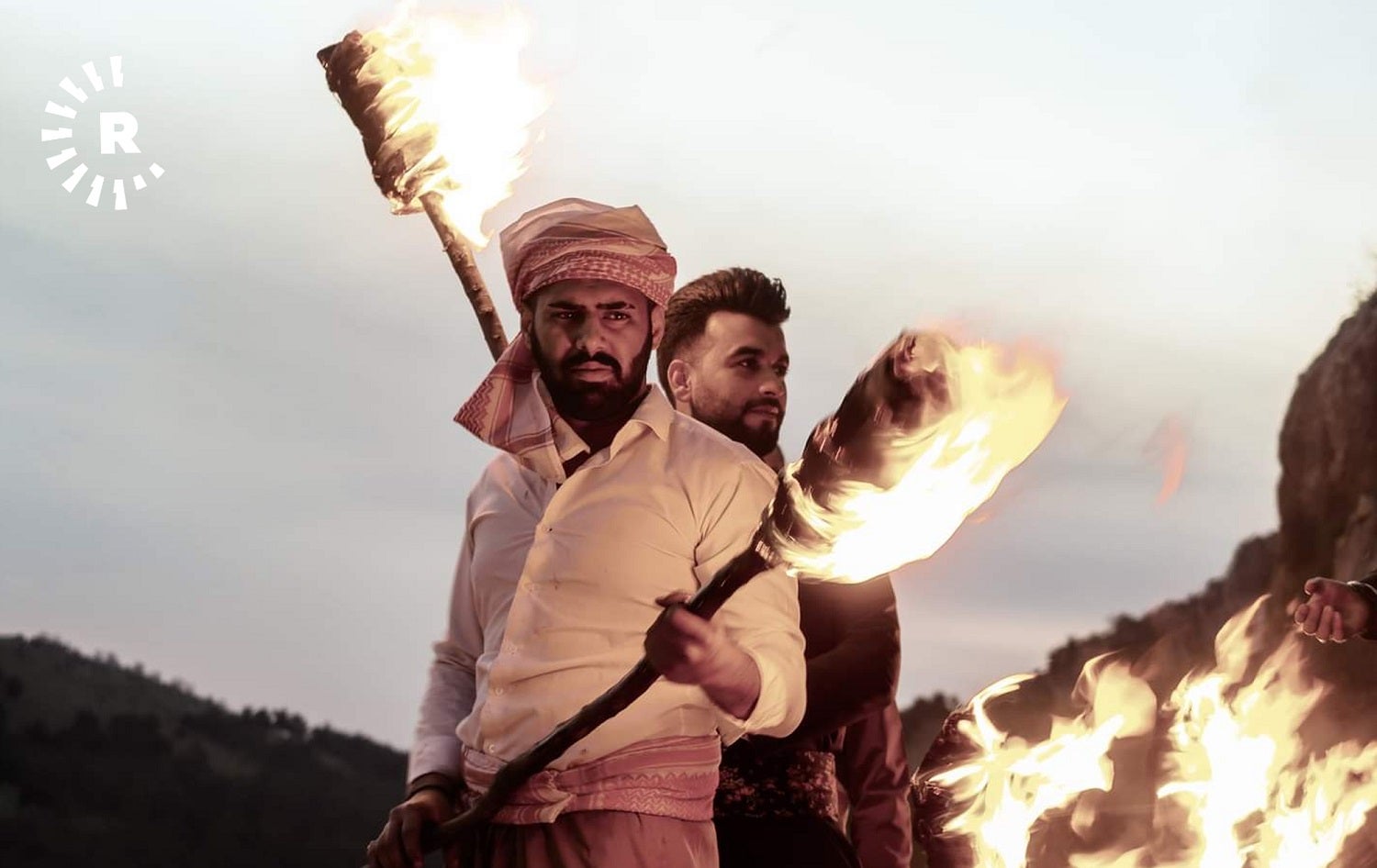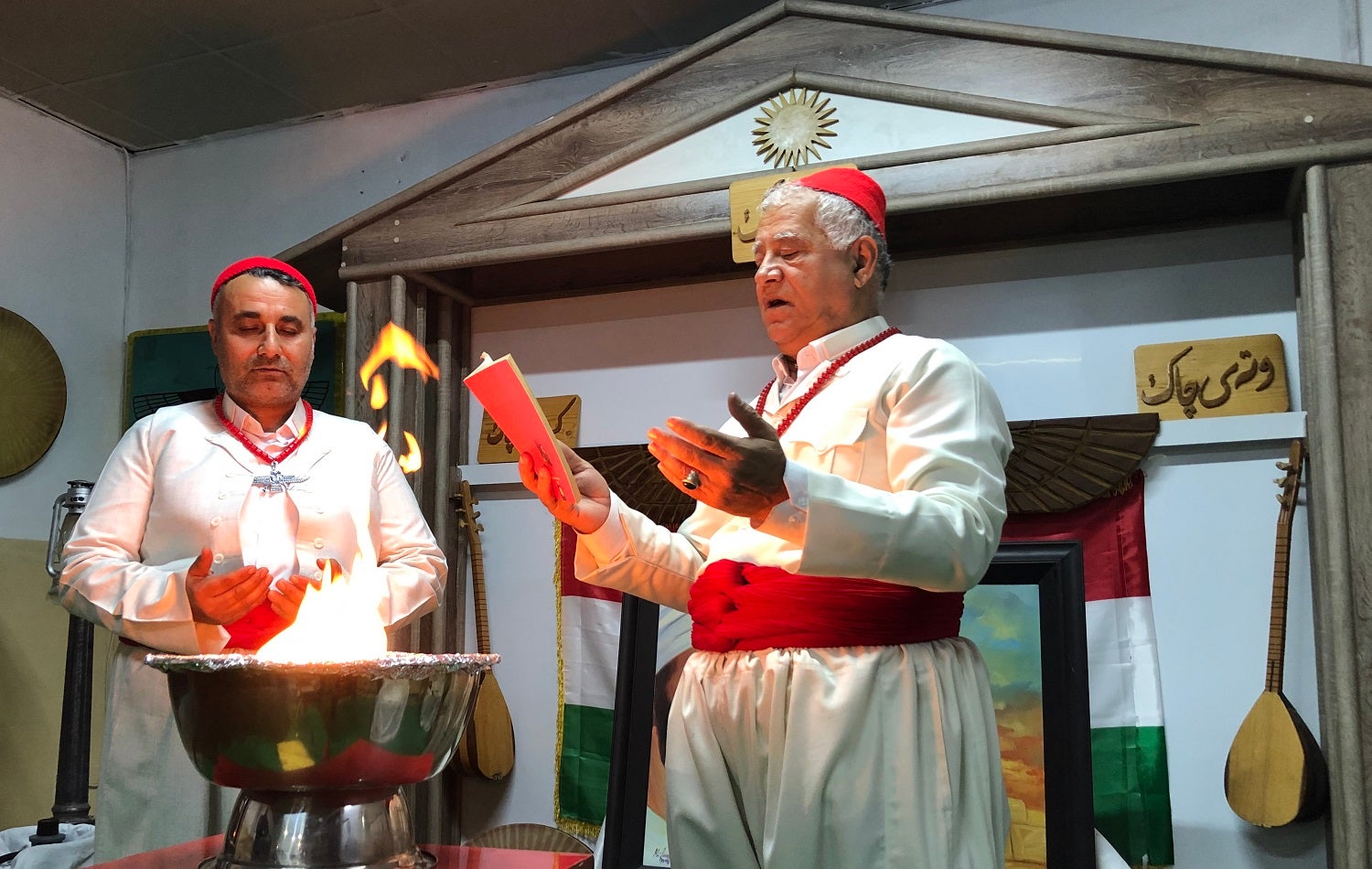
People carry torches on the Akre Hill as part of the Newroz celebrations in Duhok on March 20, 2019. Photo: Bilind T. Abdullah / Rudaw
SULAIMANI, Kurdistan Region — Whether a single flickering flame or a roaring blaze, fire is enchanting. The warmth and light draw people in, mesmerising them with the sight of dancing, jumping creatures of flame that send tufts of smoke to the heavens.
Fire is an important symbol in Kurdish culture. According to legend, Kurds are children of fire. King Solomon sent 500 jinns – beings created out of fire by God – on a mission: to head west and search for 500 beautiful virgin maidens. When the jinns returned, Solomon was dead. So the jinns took the maidens and settled with them in the Zagros Mountains, and from them the Kurdish nation was born.
In these mountains, and beyond into Iran and central Asia, fire is used to welcome the new year on the first day of spring. People gather around the Newroz fire to celebrate the triumph of new life as the warmth of spring takes the chill out of winter.
The story of the Kurdish Newroz fire centres on Kawa, a humble blacksmith who overthrew a tyrant to free his people. As is the case with most legends, there are multiple accounts of his story. One goes like this.
Long before Mesopotamia, there was a cruel king named Zuhak who lived in the Zagros Mountains. He had snakes growing out of his shoulders, a curse given to him by an evil spirit. The snakes fed on the brains of girls and boys. Zuhak demanded the surrounding villages sacrifice their children to feed his serpents.
One day, the daughter of the blacksmith was selected for sacrifice. To save her life, Kawa killed a sheep and offered the brain of the animal to the king. The king was fooled and from then on the children were safe. They were trained as warriors as they grew up until the day they attacked King Zuhak’s castle. At the head of their army was Kawa with his blacksmith’s hammer. He killed the king and lit a fire on the mountaintop to tell the people they were free. The king was dead, and the black shadow over their villages was lifted.
Today, the town of Akre is the Kurdish capital of Newroz. Every year, hundreds of people bearing torches climb the mountain overlooking the town and light a bonfire, just as Kawa did. Similar fires are ignited across Kurdish areas in Syria, Turkey, Iraq, and Iran, signs of victory over evil the night before the first day of spring.

A few days before Newroz, the last Wednesday of the year, is also marked with fire. On Chwarshama Sur (Red Wednesday), people light fires and jump over them. The leap over the flame is believed to be healing, a release of evils. Sadly, in Iran this year, three people were killed and nearly 1,900 injured in fire festival celebrations.
If someone is afraid to jump over the fire, it means he or she has sinned. But if he or she can leap over the flame, “it means they are pure,” said Asrewan Qadrok, a Zoroastrian priest in Sulaimani.
This notion of a healing flame from a sacred fire draws on Zoroastrianism, an ancient faith that was dominant in Kurdish areas during pre-Islamic times and is now gaining new followers. Zoroastrians are often called fire worshippers, but that is incorrect. “We don’t worship fire. Fire is not God. We see the light of God in the fire,” said Asrewan Qadrok.
There is a popular quote in the Zoroastrian faith: “I’m not going to draw my sword in darkness. Instead, I will light a candle to see who is there.”
When Zoroastrians pray, they always have a flame lit. It’s a source of warmth, light, energy, and healing.

Fire is used in religious traditions and held sacred across many faiths. Hanukkah is the Jewish festival of lights; in the Orthodox Christian tradition, the Holy Fire ceremony takes place on the day before Easter every year in Jerusalem; the Hindu festival of lights, Diwali, literally translates as ‘rows of lamps.’
During the Yazidi celebration of the New Year, their own Chwarshama Sur held in April, 366 candles are lit in the holy temple of Lalish, a flame for every day of the Yazidi calendar.
Flames carry the same meaning outside of formal religious settings. At memorials and vigils, people light candles as simple symbols of their thoughts and prayers, tiny flames of hope in the darkness.
In the Middle East, the holy fire can be traced back to the earliest known civilization, the Sumerians. The sacred fire is “much, much older than the Zardashti [Zoroastrians] or the Avesta [primary religious text of the Zoroastrians],” explained Hawreh Bakhawan, author of several books on Kurdish history.
He has studied clay tablets from the Sumerians that mention a sacred fire lit annually on the first of April. Bakhawan believes this is the precursor to the Newroz fire.
Though the beliefs and the myths vary, the warmth of the fire draws everyone close. “Fire is a sign of the friendship that we should keep between the people,” said Asrewan Issam, a fellow Zoroastrian priest who serves alongside Asrewan Qadrok.
“Fire is like a sign of co-existence. Newroz brings all of us together. We celebrate together."
Additional reporting by Khazan Jangiz








Comments
Rudaw moderates all comments submitted on our website. We welcome comments which are relevant to the article and encourage further discussion about the issues that matter to you. We also welcome constructive criticism about Rudaw.
To be approved for publication, however, your comments must meet our community guidelines.
We will not tolerate the following: profanity, threats, personal attacks, vulgarity, abuse (such as sexism, racism, homophobia or xenophobia), or commercial or personal promotion.
Comments that do not meet our guidelines will be rejected. Comments are not edited – they are either approved or rejected.
Post a comment